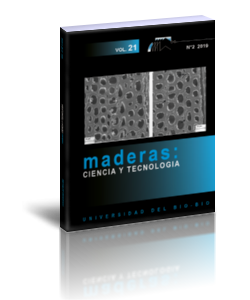Process layout planning and optimised product range selection in manufacture of wooden construction sets
Keywords:
Integer linear programming, manufacturing, near-optimal process layout, product-mix selection, wood productsAbstract
This paper introduces a systematic deterministic framework for planning and the analysis of facility layouts aimed at manufacturing a variety of parts, being components of specific end products. The essence of the proposed approach lies in the decomposition of a traditional job-shop into layout modules of generic material flow patterns, that inherently yields improved efficiency of the entire system. It entails the use of a relevant reasoning scheme based on production flow analysis and the method of hierarchical clustering of specified process routings for parts. The approach has been studied in the aspect of its application in an actual woodworking facility, dealing with fabrication of wooden toy sets. The respective workflows were subjected to the analysis in order to identify production bottlenecks using data derived from the real case study. As a result, the designated process layout alternatives have been evaluated in terms of assumed measures of the operational performance. An inseparable part of the research was exploring the capability for the optimum selection of a multi-part product mix , to be fabricated in defined time frames. In this regard, the usability as well as the computational efficacy of the integer linear programming modelling have been fully confirmed. The results gained show in particular that the suggested methodical scheme could be a useful tool in planning optimised manufacture of customised wood products of modular construction.
Downloads
References
Barni, A.; Corti, D.; Pedrazzoli, P.; Rovere, D.; Lucisano, G. 2017. Mini-factories for close-to-customer manufacturing of customized furniture: from concept to real demo. Procedia Manufacturing 11: 854-862.
Belleville, B.; Ashley, P.; Ozarska, B. 2016. Wood machining properties of Australian plantation-grown Eucalypts. Maderas. Ciencia y tecnologia 18(4): 677-688.
Dell Statistica(. 2016. Data analysis software system, ver.13. Dell Inc., <https://boomi.com/wp-content/uploads/MSA-Boomi-Master-Services-Agreement-06.25.18-4.pdf >
Ebner, M.; Petutschnigg, A.J. 2007. Potentials of thermally modified beech (Fagus sylvatica) wood for application in toy construction and design. Materials and Design 28(6): 1753-1759.
Esmaeilian, B.; Behdad, S.; Wang, B. 2016. The evolution and future of manufacturing: a review. Journal of Manufacturing Systems 39: 79-100.
Friso, V.R.; Silva, J.C.R.P.; Landim, P.C.; Paschoarelli, L.C. 2015. Ergonomic analysis of visual and tactile information of materials used in the manufacture of toys. Procedia Manufacturing 3: 6161-6168.
Gould, O.; Colwill, J. 2015. A framework for material flow assessment in manufacturing systems. Journal of Industrial and Production Engineering 32(1): 55-66.
Goyal, K.K.; Jain. P.K.; Jain, M. 2013. A comprehensive approach to operation sequence similarity based part family formation in the reconfigurable manufacturing system. International Journal of Production Research 51(6): 1762-1776.
IBM ILOG® CPLEX®. 2016. IBM ILOG® CPLEX® Optimization Studio ver.12.7<7https://ibm.onthehub.com/WebStore/ProductSearchOfferingList.aspx?srch=Cplex > (access 04.12.2017)
Irani, S.A.; Huang, H. 2005. Cascading flowlines and layout modules: Practical strategies for machine duplication in facility layouts. International Journal of Flexible Manufacturing Systems 17(2): 119-149.
Krajcovicova, M. 2011. Determination of bottlenecks in the production of wooden constructions. Drewno54 (186): 65-73.
Longo, F.; Mirabelli, G.; Papoff, E. 2006. Material flow analysis and plant lay-out optimization of a manufacturing system. International Journal of Computing 5(1): 107-116.
Moraga, M.; Baesler, F.F. 2001. The use of artificial intelligence for the optimization of a simulation model applied to a radiate pine manufacturing process. Maderas. Ciencia y tecnologia 3(1-2): 55-62.
Nakkiew, W.; Poolperm, P. 2016. Application of material flow cost accounting (MFCA) and quality control tools in wooden toys product. Intl. Conference on Industrial Engineering and Operations Management, Kuala Lumpur, Malaysia, March 2016: 801-812.
Nyemba, W.R.; Mbohwa, Ch. 2017a. Modelling, simulation and optimization of the materials flow of a multi-product assembling plant. Procedia Manufacturing 8: 59-66.
Nyemba, W.R.; Mbohwa, Ch. 2017b. Process mapping and optimization of the process flows of a furniture manufacturing company in Zimbabwe using machine distance matrices. Procedia Manufacturing 8: 447-454.
Opacic, L.; Sowlati, T. 2017. Applications of discrete-event simulation in the forest products sector: a review. Forest Products Journal 67(3-4): 219-229.
Orlowski, K.; Walichnowski, A. 2013. Analiza ekonomiczna produkcji warstw licowych podłóg klejonych warstwowo (in Polish). Economic analysis of upper layer production of engineered floorings. Drewno 56 (189): 115-126.
Preactor APS®. 2009. Production planning and scheduling software system, ver. 9.5. Preactor International Ltd., <, www.preactor.com/Home.aspx > (accessed: 03.12.2017).
Rahman, A.; Yella, S.; Dougherty, M. 2014. Simulation and optimization techniques for sawmill yard operation - a literature review. Journal of Intelligent Learning Systems and Applications 6(2): 21-34.
Siemiatkowski, M. 2010. Application of syntactic pattern recognition approach in design and optimisation of group machining systems. Solid State Phenomena 165:342-347.
Siemiatkowski, M.; Przybylski, W. 2006. Simulation studies of process flow with in-line part inspection in machining cells. Journal of Materials Processing Technology 171(1): 27-34.
Stump, B.; Badurdeen, F. 2012. Integrating lean and other strategies for mass customization manufacturing: a case study. Journal of Intelligent Manufacturing 23(1):109-124.
Sultan, A. 1993. Linear programming: An introduction with applications. ISBN: 9781463543679 San Diego, CA: Academic Press.
Teischinger, A. 2010. The development of wood technology and technology developments in the wood industries - from history to future. European Journal of Wood and Wood Products68(3): 281-287.
Thoews, S.E.; Maness, T.C.; Ristea, C. 2008. Using flow simulation as a decision tool for improvements in sawmill productivity. Maderas. Ciencia y tecnologia 10(3): 229-242.
Thomas, P.; Suhner, M.Ch.; Thomas, A. 2015. Reduced simulation model for flow analysis in a sawmill internal supply chain. Intl. Conference on Industrial Engineering and Systems Management, IESM’15, Seville, Oct 2015: 1-10.
Wood Handbook. 2010. Wood Handbook. Wood as an engineering material. Centennial Edition. US Department of Agriculture Forest Service . Forests Product Laboratory: Madison, Wisconsin.
Yin, Y.; Yasuda, K. 2006. Similarity coefficient methods applied to cell formation problem: A taxonomy and review. International Journal of Production Economics 101(2): 329-352.

































